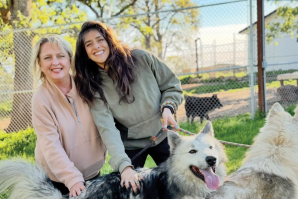His lone journey in the fall of 2011 was a long and dangerous one. Not only did he have to navigate the rugged terrain and rushing streams of Oregon on foot, there were also treacherous roads to cross, including busy Interstate 84 and four other state routes. He traveled at a fast clip, about 15 miles a day across six counties through ponderosa pine forests, sagebrush shrublands and lava flows. He was on his own — no one to help or guide him — and not sure where he was going because he’d never been in that region before. But when OR-7 crossed the Oregon border into Northern California on December 28 of that year, he was the first wild wolf to return to the state in nearly a century.
He had traveled more than 1,000 miles.
A resident of the Women for Wolves sanctuary in El Dorado County.

OR-7, given that name because he was the seventh wolf to be collared with a radio transmitter in Oregon, became a cause of celebration for wildlife experts and nature lovers. Gray wolves (Canis lupus) had become extinct in the Golden State. They were once common in California, but increasing human population and hunting drove them out. (The grizzly bear, emblemized on the state flag, also suffered that fate.) The last wolf sighting had been in 1924. But now, these animals that have long captured the human imagination, both celebrated and feared in folklore, music and art, and of particular importance in Native American cultures, are back.
Since OR-7, nicknamed Journey, made that fateful crossing, the California wolf population has grown to more than 70 since 2011. However, they remain listed under both the state and federal Endangered Species Act.
“These animals have come back, and it just shows that with the level of federal and state protections that we have afforded the species, that they do very well. They reproduce quite well. They’re very hardy,” says Axel Hunnicutt, state gray wolf coordinator for the California Department of Fish and Wildlife, from his office in West Sacramento.
Gray wolves began to recolonize in California in 2011 with OR-7, who traveled back to Oregon several times to find a mate, then returned to California where they had at least two litters of pups. As of March, there are now seven known wolf packs established in Nevada, Sierra, Plumas, Lassen, Siskiyou and Tehama counties. They are the Lassen, Beckwourth, Whaleback, Beyem Seyo, Harvey, Antelope and Yowlumni wolf packs. The California Department of Fish and Wildlife says there is also likely an unknown number of lone wolves that have dispersed from packs and wander the state. Take OR-93, a male wolf born in Oregon in 2019. He entered Modoc County in February 2021, then entered Alpine County after passing through portions of Lassen, Plumas, Sierra, Nevada, Placer, El Dorado, Amador and Calaveras counties. (He was later killed by a vehicle strike.)
Though wolves were once widespread in North America, little is known about their history. Settlers wrote about wolves but included little detail and sometimes referred to them as coyotes. Gray wolves are the largest wild members of the dog family, ranging from 40 to 175 pounds and 26 to 32 inches tall. Their ears are round, their fluffy tails are flat, and they have longer snouts, legs and bigger feet than dogs. They live in packs of two to 12 wolves, with females sometimes being the pack leader. Their main diet is deer and elk. Ciera MacIsaac, wolf care and reintroduction coordinator of the California Wolf Center in San Diego, says humans have nothing to fear from wolves. Little Red Riding Hood unfortunately made people afraid of them, but wolves fear humans just as much.
“Wolves are very, very skittish. They’re not this big bad wolf that’s gonna hunt you down that a lot of people think wolves are,” MacIsaac says. “Of people, they have what is known as neophobia. It means they’re afraid of new things. And so with that neophobia, they very much don’t like anything new, anything loud and that is all wrapped up as a human.”
Wolves were once one of the most widespread mammals in the world and were abundant across the great West, including the Sierra Nevada and its surrounding regions. Between 250,000 and 1 million wolves used to roam what would become the United States, according to an estimate from Mission:Wolf. They contributed to ecosystems, living alongside Native American peoples. But when the movement to conquer the Wild West began, settlers saw them as a savage threat and hunted them into extirpation. Even President Theodore Roosevelt, a renowned conservationist, called wolves “a beast of waste and destruction.” The California legislature put bounties on them in the 1920s. As of the 1960s, wolves were gone from the lower 48 states except for a few in northern Minnesota and Michigan.
The Department of Fish and Wildlife is currently monitoring the seven wolfpacks in California. They do so by relying on human observations and sightings of wolves. “We get a lot of information from the public, who see something while they’re driving, hiking or walking,” Hunnicutt says.
Once officials get a location, they launch a significant monitoring effort in that area. This past year, wildlife officials were able to dart 12 wolves with tranquilizers and attach GPS collars to them after spotting them by helicopter. The collars track wolf movements and behaviors. “We’ll go out and set up camera traps, or use audio recorders, or even just go out looking for tracks,” Hunnicutt says.
The extensive monitoring includes collecting pieces of fur found on barbed wire fences for DNA testing, as well as animal scat, or droppings, to determine their diet. They’ll even collect urine in the snow or soil to genetically determine whether the animals are actually wolves and not coyotes or wolf dogs, a cross breed. The biologists can determine if they have disease, are related to another pack and even where they have traveled from with this forensic information they collect.
Descendants of the Yellowstone wolves
A bold experiment was conducted 30 years ago at Yellowstone National Park. Gray wolves had gone extinct in the park, which was designated in 1872. Conservation biologists decided to recolonize the park with wolves from Canada. On January 12, 1995, a big white truck arrived from Jasper National Park in Alberta holding eight gray wolves. They were released, becoming the first wolves to roam the park since the 1920s. By the end of 1996, there were 31 wolves in the park.
Today, there are about 100. Hunnicutt says the California and Oregon wolves are descendants of the Yellowstone wolves that traveled west from the park.
Anjali Ranadivé was studying marine science and conservation at
UC Berkeley when she learned about how wolves were successfully
reintroduced at Yellowstone after 100 years. Since then, she’s
become an expert on the animal, establishing a rescue for wolves
in El Dorado County and teaching children about their importance
to our ecosystem.

The reemergence of wolves has had a profound effect on the ecosystem of the park. When the wolves were first reintroduced into Yellowstone, there was just one beaver colony in the park. Now there are nine, according to the park website. Because there were no predatory wolves, the elk population surged and overgrazed on willow and ash trees, depleting their health and affecting the habitat of other species. Now that the wolves keep the elk on the move, the trees are enjoying a renewed health, vegetation in the meadows and riverbanks has improved, and it’s helped the beavers create new spots in streams that help fish produce.
“With wolves, they are a keystone species, so they very much shape the ecosystem that they are a part of,” says MacIsaac. “We really saw that in Yellowstone, and now we’re seeking it in California.”
But the recolonization of wolves doesn’t come without problems, as they are apex predators. Ranchers in California have voiced concerns about attacks on their livestock. As a result, Fish and Wildlife offers a livestock compensation grant which is paid for in part from an appropriation from the state legislature. Under the program, ranchers would have to confirm that it was a wolf that killed their livestock, and it would be investigated by wildlife officials. (Hunnicutt noted wolves prefer forests and don’t usually prey on livestock, only if they wander into their area.) The California Wolf Center is also working with ranchers on funding non-lethal deterrent methods against wolves.
“It is exciting to see wolves back in California, but there are a lot of questions about where they fit amongst a rapidly changing landscape and new challenges for agencies and livestock producers,” Arthur Middleton, associate professor wildlife management and policy at UC Berkeley and co-lead of the California Wolf Project, said on the DFW website.
CAWP — a partnership with Fish and Wildlife and National Geographic launched last October — was created to advance the science and management of gray wolves in California. The coalition brings together scientists, wildlife managers and conservation experts to understand the social and ecological factors that shape wolf populations and help understand how to manage them.
But wolves aren’t immune to danger themselves. They are killed by car strikes, disease, and packs are known to fight each other. Poachers are still out there, killing wolves for their skins and as trophies.
“There’s 40 million people here,” Hunnicutt says. “When the wolves left, there were only a million people in California. They’re returning to a very different California.”
Get all the stories in our annual salute to women in leadership delivered to your inbox: Subscribe to the Comstock’s newsletter today.
Recommended For You

Editor’s Addendum: Meeting the Wolves
My visit to the Women for Wolves sanctuary in Placer County was a moving experience
Midway through our interview, we’re interrupted by the most incredible sound: the wolves, howling in harmony with each other. We stop talking and sit silently to take it in. It’s a beautiful, special moment.

A Chapter Ends in Oakland While Another Begins in Sacramento
The Oakland Athletics play an emotional final game at the Coliseum before moving to Sutter Health Park
The Athletics’ final game at the Oakland Coliseum after a championship run of 57 years would be a significant event under any circumstance. But the bittersweet day on Sept. 26 took on an extra dimension for the Capital Region with the A’s scheduled move to West Sacramento.

Sacramento Kings Unveil New Arena Food
Offerings include Thai and Cajun, plus ‘Light the Beam’ themed drinks and desserts
As the Sacramento Kings get ready to kick off the NBA season Thursday night, the chefs at Golden 1 Center have been busy creating new food treats for fans.

Phil Oates Is a Strong Believer in God, Philanthropy, the Sacramento Kings and Candor
At 71, the commercial real estate tycoon continues to earn community-wide kudos — and straight A’s in college
Oates rarely does “the least” he can do. He is chairman of the board of the Buzz Oates Group — a $3 billion commercial real estate investment, management and development firm founded by his late father.

Five Years After the Shelter-in-Place Order, How Is Downtown Sacramento Doing?
Sacramento businesses face mixed results since first shutdowns associated with COVID-19 pandemic in March 2020
In the first year of the COVID-19 pandemic, Comstock’s followed four downtown Sacramento businesses and their broader sectors for a six-part series. On the fifth anniversary of the shutdowns, we checked in to see how they are faring.





